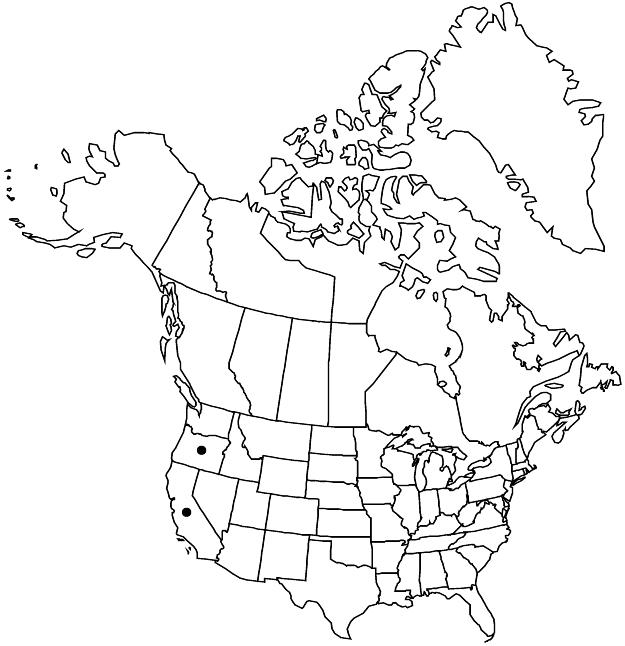Difference between revisions of "Silene lemmonii"
Proc. Amer. Acad. Arts 10: 342. 1875.
FNA>Volume Importer |
imported>Volume Importer |
||
| (5 intermediate revisions by one other user not shown) | |||
| Line 8: | Line 8: | ||
}} | }} | ||
|common_names=Lemmon’s catchfly | |common_names=Lemmon’s catchfly | ||
| + | |special_status={{Treatment/ID/Special_status | ||
| + | |code=E | ||
| + | |label=Endemic | ||
| + | }} | ||
|basionyms= | |basionyms= | ||
|synonyms={{Treatment/ID/Synonym | |synonyms={{Treatment/ID/Synonym | ||
|name=Silene palmeri | |name=Silene palmeri | ||
|authority=S. Watson | |authority=S. Watson | ||
| + | |rank=species | ||
}} | }} | ||
|hierarchy=Caryophyllaceae;Caryophyllaceae subfam. Caryophylloideae;Silene;Silene lemmonii | |hierarchy=Caryophyllaceae;Caryophyllaceae subfam. Caryophylloideae;Silene;Silene lemmonii | ||
| Line 27: | Line 32: | ||
|elevation=200-2800 m | |elevation=200-2800 m | ||
|distribution=Calif.;Oreg. | |distribution=Calif.;Oreg. | ||
| − | |discussion=<p>Silene lemmonii has typical moth-pollinated flowers. It is closely related to S. bridgesii and appears to intergrade with it. However, the small size of S. lemmonii and the presence of a compact growth of short, leafy sterile shoots usually distinguish it from S. bridgesii.</p> | + | |discussion=<p><i>Silene lemmonii</i> has typical moth-pollinated flowers. It is closely related to <i>S. bridgesii</i> and appears to intergrade with it. However, the small size of <i>S. lemmonii</i> and the presence of a compact growth of short, leafy sterile shoots usually distinguish it from <i>S. bridgesii</i>.</p> |
|tables= | |tables= | ||
|references= | |references= | ||
| Line 36: | Line 41: | ||
-->{{#Taxon: | -->{{#Taxon: | ||
name=Silene lemmonii | name=Silene lemmonii | ||
| − | |||
|authority=S. Watson | |authority=S. Watson | ||
|rank=species | |rank=species | ||
| Line 50: | Line 54: | ||
|publication title=Proc. Amer. Acad. Arts | |publication title=Proc. Amer. Acad. Arts | ||
|publication year=1875 | |publication year=1875 | ||
| − | |special status= | + | |special status=Endemic |
| − | |source xml=https:// | + | |source xml=https://bitbucket.org/aafc-mbb/fna-data-curation/src/2e0870ddd59836b60bcf96646a41e87ea5a5943a/coarse_grained_fna_xml/V5/V5_390.xml |
|subfamily=Caryophyllaceae subfam. Caryophylloideae | |subfamily=Caryophyllaceae subfam. Caryophylloideae | ||
|genus=Silene | |genus=Silene | ||
Latest revision as of 23:10, 5 November 2020
Plants perennial; taproot stout; caudex much-branched, woody, producing short, decumbent, leafy sterile shoots and erect flowering shoots. Stems 15–45 cm, pubescent and glandular-viscid distally, sparsely pubescent to ± glabrous proximally. Leaves mostly in dense basal tufts; basal blades oblanceolate to elliptic, 1–3.5 cm × 3–10 mm, narrowed to base, apex acute, scabrous-puberulent to subglabrous; cauline in 2–3 pairs, distal sessile, reduced, blade linear-lanceolate to lanceolate, 1.5–4 cm × 2–6 mm. Inflorescences cymose, (1–)3–5(–7)-flowered, open, bracteate, bracteolate, pubescent and viscid with stipitate glands; cyme open, slender-branched; bracts and bracteoles narrowly lanceolate, 2–15 mm, herbaceous. Pedicels divaricate, often curved near apex and/or at base, slender, 1/2–2 times longer than calyx. Flowers: calyx prominently 10-veined, campanulate, 6–10 × 2–4 mm in flower, broadening in fruit and becoming obconic with ± constricted base, ± as broad as long, pubescent and glandular, veins parallel, with pale commissures, lobes triangular, 1–2 mm, margins broad, membranous, apex acute; corolla yellowish white, sometimes tinged with pink, clawed, claw equaling or longer than calyx, limb deeply lobed, lobes 4, linear, 4–8 mm, appendages 2, narrow, ca. 1 mm; stamens exserted, equaling petals; styles 3, filamentous, much longer than petals and stamens, exceeding 2 times calyx. Capsules obovoid, equaling calyx and often splitting it, opening by 6 recurved teeth; carpophore 2–3 mm. Seeds rusty brown, often with gray bloom, broadly reniform, 1–1.8 mm, coarsely papillate. 2n = 48.
Phenology: Flowering spring–summer.
Habitat: Woodlands and forests, often in moist situations
Elevation: 200-2800 m
Discussion
Silene lemmonii has typical moth-pollinated flowers. It is closely related to S. bridgesii and appears to intergrade with it. However, the small size of S. lemmonii and the presence of a compact growth of short, leafy sterile shoots usually distinguish it from S. bridgesii.
Selected References
None.
